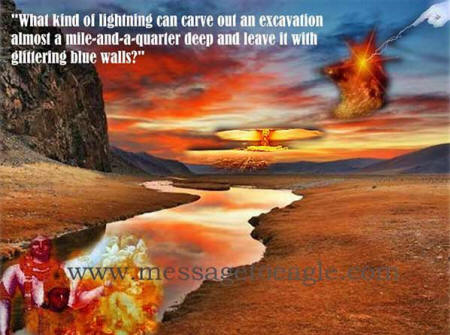|

3 June, 2014
from
MessageToEagle Website
In 1952 archaeologists conducting excavations in Israel discovered a
layer of fused green glass.
The layer was a quarter of an inch thick
and covered an area of several hundred square feet. It was made of
fused quartz sand with green discoloration, similar in appearance to
the layers of vitrified sand left after atomic tests in Nevada in
the 1950s.
Five years earlier a thin layer of the same glass, was dug up below
the Neolithic, Sumerian and Babylonian strata in southern Iraq. To
the south, the western Arabian desert is covered with black rocks
that show evidence of having been subjected to intense radiation.
These broken and burned stones are
called "harras" (page 56 -
Earth in Upheaval) that are strewn
over an area of 7,000 square miles.

"Some single fields are one hundred
miles in diameter and occupy an area of six or seven thousand
square miles, stone lying next to stone so densely packed that
passage through the field is almost impossible.
The stones are sharp-edged and
scorched black. No volcanic eruption would have cast scorched
stones over fields as large as the harras.
Neither would the stones from
volcanoes have been so evenly spread. The absence in most cases
of lava (the stones lie free) also speaks against a volcanic
origin for the stones..."
Immanuel Velikovsky - "Earth in
Upheaval"
A small piece of unusual yellow-green
glass carved into the shape of a beautiful scarab beetle is a part
of the famous pectoral of Tutankhamen and can be seen in Cairo
Museum, Egypt.
The jewel was tested and found to be glass, but surprisingly it is
older than the earliest Egyptian civilization.
The glass, known as
Libyan Desert Silica Glass,
covers a large area measuring about 30 miles east and west by 80
miles north and south and is located on the Libyan-Egyptian border.
It is 28.5 million years old and shows a grade of transparency and
purity (99 percent) that is not typical in the fusions of fallen
meteorites.
An extend area of strange, glassy stretches of fused silica have
also been found in the most desolate areas of the Gobi Desert in
Mongolia. Especially interesting are the layers discovered at Lop
Nor in Sinkiang, in the vicinity of the present Chinese atomic site.
The results obtained from examined radioactive surface in the area
indicate that layers of fused silica does not originate from the
modern nuclear detonations but had been there long before China
became a nuclear power.

This would mean that Gobi's fused silica comes from the very distant
past.
In 1908-09, ancient ruins of the city of
Khara Khoto town were unearthed, in
the Tangut province, located about 300 kilometers from the famous
Silk Highway. Working in one of the excavation sites, Piotr K.
Kozlov, the Russian archaeologist dug up a sarcophagi with two
well-preserved bodies of an unknown king and queen.
According to his estimations, the sarcophagi was buried about 12000
BC. In another excavation of the same ruins, Professor Kozlov
unearthed a large bottomless pit at the depth of 1800 meters.
Its vitrified melted walls looked like
glittering blue glass.
"Some phenomenon unknown to us must
have melted the very stone and left the shiny glazed walls.
Local tradition speaks of lightning bolts crashing down from the
heavens and hollowing out this excavation.
But what kind of lightning can carve out an excavation almost a
mile-and-a-quarter deep and leave it with glittering blue
walls?" Hartwig Hausdorf, 'The
Chinese Roswell'
The fused glass that can be found in
many places around the world has a long history and provides
physical evidence that atomic explosions were a part of Earth's
history in the past.
|


